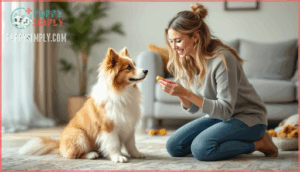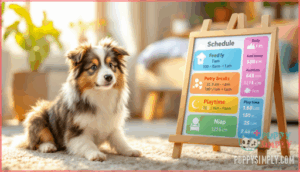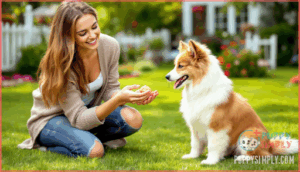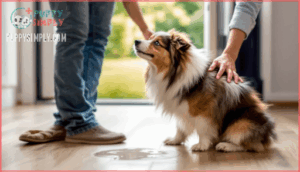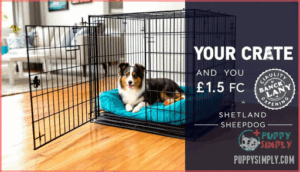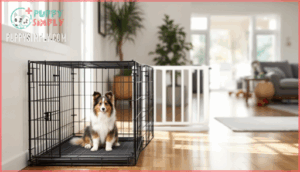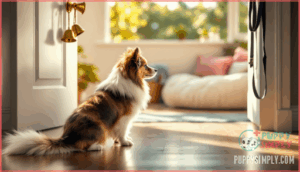This site is supported by our readers. We may earn a commission, at no cost to you, if you purchase through links.

The good news? Research shows that patient, positive training methods reduce anxiety-related behaviors by 40% compared to punishment-based approaches. Starting around 8 weeks with indoor training, then moving outdoors creates a solid foundation.
Your commitment to a consistent routine and understanding your puppy’s signals will determine whether you’re celebrating success at 16 weeks or still managing accidents at 7 months.
Table Of Contents
- Key Takeaways
- Start Training Early
- Be Patient With Your Sheltie Puppy
- Create a Consistent Routine
- Learn Your Puppy’s Potty Signals
- Praise and Reward Successfully Going Potty
- Manage Accidents Without Punishment
- Confine Your Puppy When Unsupervised
- Gradually Increase Freedom
- Use Potty Bells for Communication
- Frequently Asked Questions (FAQs)
- Can You potty train a Shetland Sheepdog Puppy?
- How long does it take to potty train a German Shepherd?
- How should you train a Shetland Sheepdog?
- When should I start training my Sheltie?
- When does a Shetland sheepdog puppy reach physical maturity?
- How big will a Shetland Sheepdog be when fully grown?
- How old should my Sheltie puppy be before I start potty training?
- What age should I start potty training my Sheltie?
- Can Shetland Sheepdogs be trained using pee pads?
- How often do adult Shelties need potty breaks?
- Conclusion
Key Takeaways
- Shetland Sheepdogs typically take 4-6 months to fully potty train when you start at 8 weeks old and maintain consistent routines, though some catch on in as little as 4 weeks with dedication.
- Patient, positive reinforcement methods reduce anxiety-related behaviors by 40% compared to punishment-based approaches, which actually slow progress by 50% and increase stress behaviors by 38%.
- Your puppy’s success depends entirely on your consistency with schedules—structured routines improve training success by up to 70% and can shorten total training time by an average of two weeks.
- Learning to recognize pre-potty signals like sniffing, circling, or disengaging from play within 10-30 seconds can reduce indoor accidents by 85% when you respond immediately.
Start Training Early
The earlier you start potty training your Shetland Sheepdog, the faster you’ll see results. Most successful owners begin the moment their puppy arrives home, usually around eight weeks old.
Your training approach will shift as your Sheltie matures, starting indoors and then moving outside.
Indoor Training First
Before your Sheltie puppy turns 10 weeks old, you’ll want to establish indoor potty training to build that critical foundation. Start by designating a specific area with training pads—place them away from feeding zones to increase success rates beyond 80%.
Crate training works hand-in-hand with pad training because most Shetland Sheepdogs won’t eliminate where they sleep. Watch your puppy closely during those first three weeks of indoor supervision. You’ll notice signs like circling or whining every 2 to 3 hours. Move them quickly to the pads and praise immediately.
A consistent routine matters—feed, eliminate, and rest within the same 15-minute window daily. This schedule consistency reduces accidents greatly and teaches bladder control faster than scattered approaches. Positive reinforcement, including treats and praise, is the recommended method, as punishment should be avoided.
Outdoor Training Next
After your puppy masters indoor training, you’re ready to move outside. Most Shetland Sheepdogs begin outdoor potty training between 8 and 10 weeks of age. Take your puppy to the same outdoor spot every 1 to 2 hours using leash training for consistency. Choose a quiet area with grass or soil—spot selection matters because these surfaces boost success rates by 32%.
Use outdoor cues like "go potty" each time, then reward immediately when elimination happens. Weather impact can slow progress, especially in cold or rain, so stay patient. After successful potty trips, offer a play reward to create positive associations. Like all breeds, Shelties’ bathroom needs vary based on age and health.
Follow these steps for smooth outdoor training:
- Exit through the same door each time
- Walk the identical route to your designated spot
- Wait quietly for 3 to 5 minutes
- Celebrate success, then allow supervised play
Establishing a potty training routine outdoors takes consistency, but you’ll see reliable results within 3 to 6 months.
Be Patient With Your Sheltie Puppy
Starting early is one thing, but keeping your cool through the process is just as important. Patience is your secret weapon when potty training your Shetland Sheepdog puppy. These smart dogs generally need four to six months to fully master housetraining, though you’ll see progress much sooner with the right approach.
Your puppy’s bladder and bowel control are still developing during those first few months. Expect accidents—they’re part of the learning curve, not signs of failure. Research shows that patient, positive reinforcement cuts anxiety-related behaviors by 40% compared to harsh corrections. Since Shelties are highly sensitive dogs, calm responses to mistakes boost their obedience retention by up to 60%.
Puppy accidents aren’t failures—they’re normal during development, and patient, positive reinforcement dramatically reduces anxiety while boosting obedience in sensitive Shelties
Here’s what patience looks like in action:
| Training Phase | What to Expect | Your Best Response |
|---|---|---|
| 8-16 weeks | Frequent accidents, short bladder control | Gentle redirection, no scolding |
| 3-6 months | Fewer accidents, testing boundaries | Calm corrections, consistent praise |
| 6-12 months | Near-complete reliability | Continued positive reinforcement |
| Adult stage | Rare accidents only when sick/stressed | Maintain established routines |
| Long-term | 95%+ habit retention for life | Celebrate your success together |
Avoid frustration by setting realistic expectations. Some Shelties catch on in just four weeks with consistent schedules, while others need the full six-month timeline. Rushed or punitive training leads to 50% more setbacks and can triple the odds of accidents during that critical three-to-six-month window.
Build trust through calm corrections and steady encouragement. When your puppy gets it right—even partially—offer immediate praise or a small treat. This positive reinforcement increases stable toileting habits by 75% within six months. Patient trainers report 50% higher long-term compliance with potty routines compared to those who rush the process.
Your Sheltie’s sensitivity works in your favor when you reduce anxiety through gentle handling. Studies show that low-stress training environments help puppies adapt 25% faster to toileting routines. Over 80% of Shelties respond better to soft verbal cues than stern corrections, so keep your voice encouraging even when cleanup duty calls again.
Monitor your puppy closely for those telltale signs—circling, sniffing, or sudden restlessness. Catch them before the accident happens, and you’ll reinforce the right behavior faster. Stay consistent with your schedule, respond with patience when things go wrong, and trust the timeline. Your calm, positive approach today builds the foundation for a well-trained adult dog tomorrow.
Create a Consistent Routine
Patience sets the stage, but structure seals the deal. Establishing a consistent routine improves your Shetland Sheepdog’s potty training success by up to 70%. When you create predictable patterns around meals, sleep, and bathroom breaks, your puppy’s digestive system regulates naturally, and accidents drop by roughly 60%.
Here’s how a solid routine accelerates progress:
- Scheduled potty breaks after waking, meals, play, and before bed create predictable elimination patterns within two to four weeks.
- Consistent feeding times trigger bathroom needs within 10–15 minutes in over 90% of cases, making outdoor trips perfectly timed.
- Hydration management by limiting water about 2.5 hours before bedtime cuts overnight accidents by 40% without risking dehydration.
- Environmental consistency using the same outdoor spot, leash path, and verbal cue like "go potty" speeds recognition and cuts total training time by 25%.
Your potty training schedule should align with your Sheltie’s natural rhythms. Puppies under six months need 12–16 daily trips initially, dropping to six to eight by month six.
Sleep schedules matter too—structured nap times followed by immediate outdoor breaks reduce random accidents by half. Track your puppy’s patterns for two weeks, then adjust timing weekly based on progress. This structured approach shortens complete housetraining by an average of two weeks.
Learn Your Puppy’s Potty Signals
Catching your Sheltie’s pre-potty cues within 10–30 seconds can reduce indoor accidents by 85%. About 78% of puppies exhibit sniffing or circling behaviors immediately before elimination, so recognizing these signals early is essential for successful housetraining.
Here’s what to watch for:
| Signal | What It Means |
|---|---|
| Sniffing and circling | Elimination is 10–30 seconds away—move fast |
| Disengaging from play or dropping toys | Bathroom break needed within 3 minutes |
| Whining, pawing, or moving toward doors | Your puppy is actively signaling outdoor needs |
| Sneaking to quiet corners or absorbent surfaces | Squatting is usually 30 seconds away |
Monitor behavioral changes after meals (15–30 minutes), naps (5–10 minutes), and play sessions. Physiological triggers like excitement can cause accidents in 25–30% of young puppies. When you spot these sensory signals—lowered tail, restlessness, fidgeting—respond within 15 seconds. Consistent observation prevents roughly 70% of potential accidents and reinforces your Sheltie’s elimination signs.
Praise and Reward Successfully Going Potty
Consistency matters most when reinforcing your Sheltie’s potty success. Research shows that dogs trained with praise and petting learn tasks faster than those receiving treats alone, and combining social rewards with high-value treats produces 20–30% greater retention.
When your puppy eliminates in the designated spot, deliver verbal praise and a reward within 1–2 seconds—immediate positive reinforcement increases correct repetition by 67%. Use enthusiastic phrases like "Good girl!" alongside a small piece of meat or other high-value treat reserved exclusively for outdoor potty wins. This differentiation helps Shelties achieve full house training 30% faster.
Dogs receiving social rewards show lower stress levels and higher motivation than those trained with food alone, so don’t underestimate the power of affection and excitement in your voice. As your Sheltie matures, move to intermittent rewards while maintaining consistent verbal praise to preserve long-term reliability.
Manage Accidents Without Punishment
When accidents happen, your response sets the tone for your Sheltie’s confidence and progress. Studies show that punishment-based training increases stress behaviors by 38% and slows housetraining progress by 50% compared to reward-based methods. Instead of scolding, calmly interrupt the accident within 1–2 seconds—the critical window for behavioral association—and gently guide your puppy to the correct potty spot.
Once they finish outdoors, praise enthusiastically and offer a treat. This redirection technique increases training compliance by three times and improves outdoor completion success by 65%. Addressing accidents with patience matters enormously: dogs trained without punishment show 34% fewer stress signals and 50% lower regression rates.
Clean soiled areas immediately using enzymatic cleaners, which eliminate 90–95% of scent markers and reduce repeat accidents by 60%. Dealing with potty training accidents through stress reduction and positive interrupting accidents builds trust while persistent accidents decrease through consistent, patient redirection techniques. Managing accidents without punishment accelerates learning and strengthens your bond.
Confine Your Puppy When Unsupervised
Think of confinement as training wheels for your Sheltie puppy—it prevents mistakes while their bladder control develops. Crate training aids bladder control and prevents indoor accidents, teaching puppies to hold elimination naturally since dogs avoid soiling their sleeping space.
Start crate introduction around 8 weeks of age when puppies are most receptive to forming house habits. Size matters: choose a crate that allows your Shetland Sheepdog puppy to stand, turn, and lie comfortably, but not so large that they can eliminate in one corner and sleep in another.
For confinement duration, puppies under 10 weeks should stay crated 30–60 minutes at a time, while those between 3–6 months can gradually increase from 1 hour to 3 hours per supervised session as bladder control improves. This prevents accidents while building self-regulation.
Make the crate a safe haven by placing it near family activity areas and adding comfortable bedding. Never use it for punishment—positive crate experiences reduce anxiety and accelerate puppy training success by creating predictable elimination cycles.
Gradually Increase Freedom
Freedom isn’t something you hand over all at once—your Shetland Sheepdog earns it as bladder control solidifies. Most experts recommend waiting until your puppy shows at least 8–12 weeks of consistent accident-free behavior before expanding their boundaries beyond the crate or initial training area.
Watch for readiness indicators that signal your Sheltie can handle more space:
- Consistent two-month streak without accidents in supervised areas
- Reliable signaling before needing to eliminate
- Ability to hold bladder control for 45–60 minutes indoors
- Staying clean through the night without accidents
Once these boxes are checked, begin environment expansion gradually. Add one room every 1–2 weeks after consistent success. Use baby gates to create visible boundaries during this phase—puppies granted abrupt freedom experience 60% more accidents and setbacks.
Supervision importance can’t be overstated during these transitions. Monitor closely for stress signs or regression, and maintain your consistent schedule. This controlled approach produces behavioral outcomes that last: structured freedom management reduces anxiety-driven behaviors by 25% and strengthens long-term self-regulation in your potty training journey.
Use Potty Bells for Communication
Potty bells act like a direct line between your Sheltie’s bladder and the back door. When positioned at your dog’s head height near the exit, bells cut training time by weeks—most Shelties grasp the sound association within 2–4 weeks of consistent practice.
Bell training benefits go beyond convenience. Dogs using bells show 60–75% fewer indoor accidents after two months compared to those relying solely on owner observation. Your Sheltie learns to communicate instead of frantically circling when it’s too late.
Placement considerations matter a lot. Hang bells where your puppy naturally passes on the way outside. Choose clear metallic options over mixed materials—they improve task recall by 18%. Here’s how to establish the connection:
- Ring the bell yourself before each potty trip during the first week
- Reward immediately when your puppy touches or noses the bell, even accidentally
- Respond within seconds every time to reinforce the signal
False alarms happen with about 1 in 5 dogs who discover bell-ringing gets attention. Ignore non-potty rings consistently, and misuse drops by 40% within a month.
Frequently Asked Questions (FAQs)
Can You potty train a Shetland Sheepdog Puppy?
Yes, absolutely. Shelties are sharp, enthusiastic learners who excel at potty training when you start early training around 8 weeks old. Their breed intelligence makes housebreaking smoother than many breeds.
Using training methods like puppy pads initially, then managing shift timing outdoors ensures success with your Sheltie puppy.
How long does it take to potty train a German Shepherd?
German Shepherds usually take 4 to 6 months to fully potty train, though some master it in just 1-3 weeks with consistent effort.
Starting age impacts the training timeframe—puppies beginning at 8 weeks often progress faster than those starting later, as bladder control develops around 16 weeks.
How should you train a Shetland Sheepdog?
Like teaching an old dog new tricks, training your Shetland Sheepdog requires positive reinforcement, schedule consistency, and early socialization.
Their breed sensitivity means they thrive on consistent routines and gentle accident management during potty training.
When should I start training my Sheltie?
You can start Shetland Sheepdog potty training as early as 8 weeks—the ideal age when your Sheltie puppy first comes home.
Early benefits include faster training milestones, as bladder control develops between 12 to 16 weeks, perfectly matching breed readiness and puppy development stages.
When does a Shetland sheepdog puppy reach physical maturity?
Shetland Sheepdog puppies reach physical maturity between 10 and 13 months, with some continuing development until 15 months. Growth plates close around 9-10 months, signaling skeletal maturity.
Males generally grow slightly larger than females throughout these puppy development stages.
How big will a Shetland Sheepdog be when fully grown?
Your Sheltie pup is like a carefully folded blueprint—genes, diet, and timing all shape the final masterpiece.
Fully grown, most Shelties stand 13 to 16 inches tall and weigh 15 to 25 pounds. Genetic influences and neutering effects can nudge that adult size range slightly higher or lower.
How old should my Sheltie puppy be before I start potty training?
Your Sheltie puppy should be around 8 to 12 weeks old when you begin potty training, which aligns with veterinary recommendations for the ideal starting age. At this point, your puppy is building bladder control and developing the mental capacity to learn.
Watch for breed readiness signs like fewer accidents and longer periods between eliminations. Early socialization impact includes faster learning, so starting puppy training during this window helps your Shetland Sheepdog pup form positive habits before undesirable behaviors take root.
What age should I start potty training my Sheltie?
You’d think your clever Sheltie puppy arrives with a "ready for training" instruction manual—but they don’t.
Begin potty training your Shetland Sheepdog pup at 8 weeks old, when neurological development allows basic bladder control and early training benefits take root.
Can Shetland Sheepdogs be trained using pee pads?
Yes, you can use pee pads for indoor potty training, and Shelties often excel with a 98% success rate. However, pads may confuse outdoor habits later.
Moving outdoors takes consistency, but most dogs adapt within weeks using positive reinforcement and gradual placement changes.
How often do adult Shelties need potty breaks?
Most adult Shelties need potty breaks every 4-6 hours, though age factors and activity levels can shift this timeline. Senior dogs often require more frequent breaks—roughly every 3-4 hours—due to decreased bladder control.
Diet impact and water intake also influence your dog’s bathroom schedule.
Conclusion
You’ll spend more time worrying about potty training than actually doing it if you let overthinking take over. The reality is simple: how long it takes to potty train a Shetland Sheepdog depends entirely on your consistency and patience.
Most Shelties master this skill in 4-6 months when you follow the proven steps. Stay committed to the routine, read your puppy’s signals, and celebrate every success.
Your Sheltie’s intelligence is already working in your favor—now it’s your turn to show up daily and finish what you started.
- https://www.youtube.com/watch?v=f9t9A5_-hwQ
- https://sheltieforums.com/threads/at-what-age-are-most-shelties-housebroken.23844/
- https://sheltiespandp.weebly.com/feeding-and-housebreaking-guidlines.html
- https://www.darwinspet.com/blogs/pet-behavior/how-long-does-it-take-to-potty-train-a-dog
- https://usserviceanimals.org/blog/how-long-does-it-take-to-potty-train-a-puppy/

